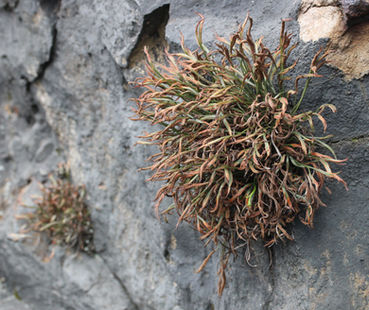Flies
43 species of fly have become extinct in England in the last 200 years, 10 of which are shown below

Species: Belida angelicae
Extinct: 1936

Species: Clitellaria ephippium
Extinct: 1850
© John Reinecke
© Hectonichus


FORKED SPLEENWORT
Asplenium septentrionale

A rare species of fern that has experienced a rapid decline and has a high risk of extinction in Southern England.
-
Rarity: Known from only 2 declining native sites in Southern England and a cluster in the North. More common in Scotland and Wales
-
Cause of decline: Over-collecting during the Victorian period, over or under shading, encroachment of competing vegetation, & potentially pressures from a warming climate
Background
Forked Spleenwort is a unique fern amongst rock-dwelling pteridophytes, with its almost grasslike delicate fronds, making it instantly recognisable.
Although never common in England, its current occupation of just two sites gives great cause for concern for its long-term survival. Our work is focussing on keeping these two populations extant, while collecting more data about its occurrence in Scotland and Wales; both to ensure its wider national survival, and learn more about its ecology.
Historically it has been threatened by sites becoming scrubbed over, and its reliance on newly created or maintained rock faces. In recent years the run of exceptionally hot summer periods and the detrimental impact this has had on plants in England have given cause for concern that climate change may also have a large impact on this and other species which occupy bare rock niches.
Ecology and Conservation
Forked Spleenwort is epipetric (growing on rocks) and can be found in crevices of rocks, around boulders and on cliffs on a variety of substrates, including granitic rocks & limestone. In these situations it is generally found in areas with small cracks and crevices which are small enough to prevent larger vascular plants from colonising.
This distinctive fern has long slender, almost grasslike leaves which can form dense clusters. The fronds are monomorphic and can grow up to 8cm, and often, but not always, have forked tips. Blades are green turning purple to brown at the base, and sori are linear and covered in pale indusia.
Forked Spleenwort is evergreen and long-lived, but does exhibit some dieback at the end of summer. Like other ferns it has a double generational lifecycle, but little is known about its gametophyte stage.
Our Work
We remain very concerned about the survival of this species in England, with both southern sites showing population decline in recent years. As well as annual monitoring, we liaise with land managers to ensure management is effective in removing over-shading & competing vegetation. Recent surveys in the Lake District, North Wales and Scotland have revealed much healthier populations in these areas, which we will continue to keep an eye on.
In 2023, working with the Royal Botanic Gardens Edinburgh, we were able to create an ex situ population of plants, and will be using this to attempt to re-introduce plants to extinct sites and expand its range, especially in the south.




